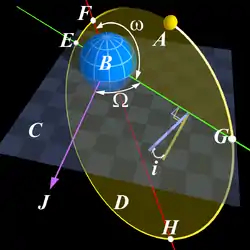Payload fraction
In aerospace engineering, payload fraction is a common term used to characterize the efficiency of a particular design. Payload fraction is calculated by dividing the weight of the payload by the takeoff weight of aircraft. Fuel represents a considerable amount of the overall takeoff weight, and for shorter trips it is quite common to load less fuel in order to carry a lighter load. For this reason the useful load fraction calculates a similar number, but based on the combined weight of the payload and fuel together.
| Part of a series on |
| Astrodynamics |
|---|
 |
Propeller-driven airliners had useful load fractions on the order of 25-35%. Modern jet airliners have considerably higher useful load fractions, on the order of 45-55%.
For spacecraft the payload fraction is often less than 1%, while the useful load fraction is perhaps 90%. In this case the useful load fraction is not a useful term, because spacecraft typically cannot reach orbit without a full fuel load. For this reason the related term propellant mass fraction, is used instead. However, if the latter is large, the payload can only be small.
Examples
| Vehicle | Takeoff Mass | Final Mass | Mass ratio | Payload fraction |
|---|---|---|---|---|
| Ariane 5 (vehicle + payload) | 746,000 kg [1] (~1,645,000 lb) | 2,700 kg + 16,000 kg[1] (~6,000 lb + ~35,300 lb) | 39.9 | 2.506% |
| SpaceX Starship (vehicle + payload) | 4,400,000 kg (9,700,000 lb) [2] | 85,000 kg (187,000 lb)[2] + 100,000 kg (220,000 lb)[3] | 18.7 | 5.341% |
| SpaceX Starship (payload only) | 4,400,000 kg (9,700,000 lb) [2] | 100,000 kg (220,000 lb)[3] | 29.3 | 3.409% |
| Soyuz-2.1b | 312,000 kg | 8,200 kg[4] | 38.05 | 2.63% |
| Soyuz-2.1a | 312,000 kg | 7,020 kg[4] | 44.444 | 2.25% |
| Saturn V | 3,038,500 kg[5] (~6,700,000 lb) | 13,300 kg + 118,000 kg[5] (~29,320 lb + ~260,150 lb) | 23.1 | 4.33% |
| Space Shuttle (vehicle + payload) | 2,040,000 kg (~4,500,000 lb) | 104,000 kg + 28,800 kg (~230,000 lb + ~63,500 lb) | 15.4 | 6.49% |
| Space Shuttle (payload only) | 2,040,000 kg (~4,500,000 lb) | 28,800 kg (~230,000 lb + ~63,500 lb) | 70.83 | 1.41% |
| Skylon (vehicle + payload) - projected | 345 tons [6] | 15 + 53 | 5.07 | 19.71% |
| Skylon (payload) - projected | 345 tons[6] | 15 | 23 | 4.35% |
| Saturn 1B (stage only) | 448,648 kg[7] (989,100 lb) | 41,594 kg[7] (91,700 lb) | 10.7 | 9.346% |
| Titan 23G first stage | 117,020 kg (258,000 lb) | 4,760 kg (10,500 lb) | 24.6 | 4.065% |
| Virgin Atlantic GlobalFlyer | 10,024.39 kg (22,100 lb) | 1,678.3 kg (3,700 lb) | 6.0 | 16.66% |
| V-2 | 13,000 kg (~28,660 lb) (12.8 ton) | 3.85 | 25.97% [8] | |
| X-15 | 15,420 kg (34,000 lb) | 6,620 kg (14,600 lb) | 2.3 | 43.478%[9] |
| Concorde | ~181,000 kg (400,000 lb [9]) | 2 | 50%[9] | |
| Boeing 747 | ~363,000 kg (800,000 lb[9]) | 2 | 50%[9] | |
| Lunar Module Descent stage | 15,200 kg [10] | 6,845 kg | 2.22 | 45.03%[10] |
| Lunar Module Ascent stage | 4,780 kg [10] | 2405 kg | 1.9875 | 50.31%[10] |
Note: the above table may incorrectly include the mass of the empty upper stage or stages.
See also
References
- Astronautix- Ariane 5g
- "Making Life Multiplanetary: Abridged transcript of Elon Musk's presentation to the 68th International Astronautical Congress in Adelaide, Australia" (PDF). SpaceX. September 2017.
- spacexcmsadmin (2019-09-27). "Starship". SpaceX. Retrieved 2019-11-10.
- "SOYUZ-2 Launch Vehicle / Power Characteristics". JSC SRC Progress. Retrieved 2015-08-20.
- Astronautix - Saturn V
- Skylon user's manual
- Astronautix- Saturn IB
- Astronautix-V-2
- AIAA2001-4619 RLVs
- Lunar module